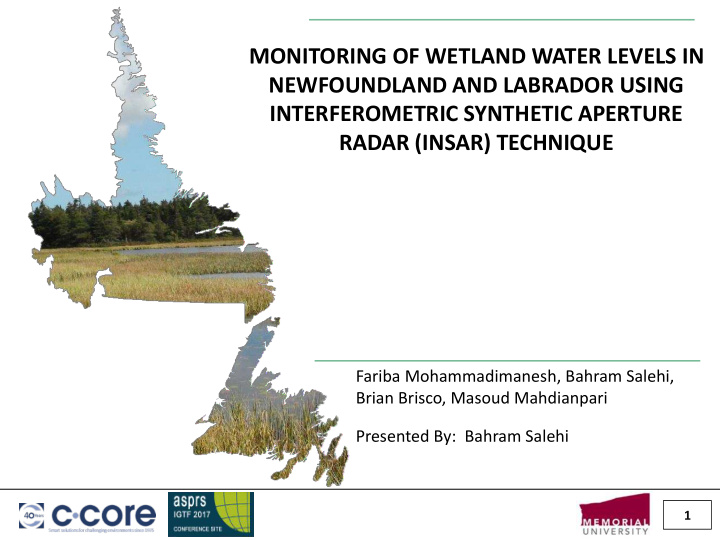



MONITORING OF WETLAND WATER LEVELS IN NEWFOUNDLAND AND LABRADOR USING INTERFEROMETRIC SYNTHETIC APERTURE RADAR (INSAR) TECHNIQUE Fariba Mohammadimanesh, Bahram Salehi, Brian Brisco, Masoud Mahdianpari Presented By: Bahram Salehi 1
Outline Introduction Satellite radar sensors How to measure deformation phenomena from space Interferometric Synthetic Aperture Radar (InSAR) and its advancements InSAR Wetland Important parameters Study area and dataset Results 2
Satellite Radar Sensors A Synthetic Aperture Radar (SAR) sensors illuminates the Earth surface using a coherent microwave beam radiation such as laser. X-Band 𝜇 = 3.1 cm C-Band 𝜇 =5.7 cm L-Band 𝜇 =23.6 cm 3
Radar vs optical imagery imuth Azim Az Op Optic ical Ra Radar 4
Radar vs optical imagery Range 1. Day/night monitoring, Active system, no need for external illumination 2. All-weather Penetration through clouds, rain, dry soil, and Azimuth partial vegetation Ra Radar 5
SAR image A SAR image is a set of pixels characterized by both amplitude and phase values. Amplitude Phase 6
SAR Interferometry In SAR interferometry, phase component is used, and it is related to Sensor-Target distance . The two SAR images are generally acquired from slightly different imaging geometries. The second SLC must be precisely co-registered and resampled to the geometry of the first SLC. 7
A SAR Interferogram example −𝝆 +𝝆 Phase variation( 𝝌) −𝟐𝟓 +𝟐𝟓 Range variation(mm ) 8
InSAR limiting factors Phase change between images depends on several factors that must be removed before measuring deformation: ∆∅ = ∅ 𝐸𝑓𝑔 + ∅ 𝑃𝑠𝑐𝑗𝑢 + ∅ 𝑈𝑝𝑞𝑝 + ∅ 𝐵𝑢𝑛 + ∅ 𝑂𝑝𝑗𝑡𝑓 9
Advanced InSAR techniques Using a long series of SAR data Identifying coherent radar targets (Permanent Scatters) , where atmospheric effects can be estimated and removed. After removing all undesirable terms, just phase changes related to deformation will be remained. 10
Wetland InSAR Water Volume Backscattering Specular Backscattering Volume Backscattering 11
Important factors in using InSAR for wetland monitoring 12
Wetland types Freshwater Swamp Marsh Shallow water Bog Fens Swamp forest Marsh 13
Wavelength Longer wavelengths, better penetration X-Band(3.1 cm):Upper section of vegetation canopy. C-Band(5.6cm):Penetrates further (maybe entire canopy). L-Band(24cm ): Throughout vegetation and interacts with the surface beneath the vegetation. 14
Polarization The phenomenon ,wherein wave radiations are restricted to direction of vibration. Water level changes can be detected by all polarization. HH polarization can maintain better coherent than other polarizations for flooded vegetation. VV is the second best. (Sang-Hoon Hong et al., 2010) 15
Other factors Temporal baseline Perpendicular baseline 16
Study area 17
Dataset Name Number of 5 images Acquisition Ultrafine type Beam mode U16W2 Polarization HH Resolution 2.4m Pass direction Descending 18
Methodology Standard repeat-pass interferometry technique 5 Radarsat-2 images in Ultrafine mode 10 interferograms were produced Topographic phase was removed using an external Digital elevation Model(DEM) Some patterns were detected From 10 produced interferograms, just two interferograms with temporal baseline of 24 days illustrated an adequate coherence. 19
Small Baseline SAbset Interferogram 20
Consecutive coherence maps 24 days 24 days 48 days 24 days N N N N 20160421_20160515 20160515_20160608 20160608_20160726 20160726_20160819 0 1 0 1 0 1 0 1 21
Interfergram 𝐶 𝑈 = 24 d 𝐶 𝑈 = 24 d N N 𝐶 𝑄 = 82.49 m 𝐶 𝑄 = 82.49 m 0 1 Interferogram Coherence 20160515_20160608 22
Interfergram 𝐶 𝑈 = 24 d N N 𝐶 𝑈 = 24 d 𝐶 𝑄 = 194.12 m 𝐶 𝑄 = 194.12 m 2 𝜌 0 1 0 Interferogram Coherence 20160726_20160819 23
First field trip(May 2016) White hill industrial park Torbay wetland Pippy park Mount pearl 24
Detected patterns 20160515_20160608 20160726_20160819 Interferogram Coherence 25
Detected patterns 20160515_20160608 20160726_20160819 Interferogram Coherence 26
Detected patterns 20160515_20160608 20160726_20160819 Interferogram Coherence Marsh is very difficult to be find by Google Earth image. Not much open-water Mostly highly water saturated soils, like as peatland, and bogs. 27
Detected patterns 20160515_20160608 20160726_20160819 Coherence Interferogram 28
Conclusion 5 Radarsat-2 SAR data were processed and 10 interferograms in time interval between April to August 2016 were produced. No patterns were detected in the marsh areas that have been detected in the first field trip (May 2016). Some patterns were detected in other areas and the next field trip showed (September 2016) that they were related to wetland bodies. The results were the preliminary results of this study, more analysis should be done to extract water level height from the phase data. 29
Acknowledgments Thanks for your attention 30
Recommend
More recommend